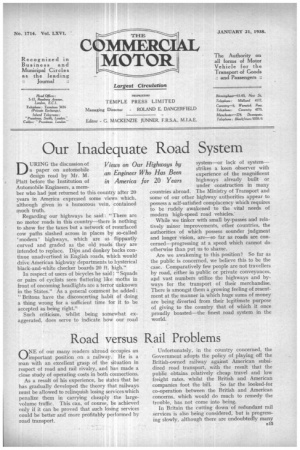Road versus Rail Problems
Page 1

Page 2

If you've noticed an error in this article please click here to report it so we can fix it.
ONE of our many readers abroad occupies an important position on a railway. He is a man with an excellent grasp of the situation in respect of road and rail rivalry, and has made a close study of operating costs in both connections.
As a result of his experience, he states that he has gradually developed the theory that railways must be allowed to relinquish losing services which penalize them in carrying cheaply the largevolume traffic. This can, of course, be achieved only if it can be proved that such losing services could be better and more profitably performed by road transport. Unfortunately, in the country concerned, the Government adopts the policy of playing off the British-owned railway against American subsidized road transport, with the result that the public obtains relatively cheap travel and low freight rates, whilst the British and American companies foot the bill. So far the looked-for co-operation between the British and American concerns, which would do much to remedy the trouble, has not come into being.
In Britain the cutting down of redundant rail services is also being considered, but is progressing slowly, although there are undoubtedly many s15 hundreds of miles of track which must, from the railway point of view, constitute a white elephant, and where either railcars or road motors could provide a better, cheaper and more-frequent service. If necessary, the rails could be torn up and the beds utilized as the foundation of easily graded motor roads.
The Ministry Calling for Road Transport Returns UNDER the provisions of Section 75 of the Road Traffic Act, 1930, the Minister of Transport is entitled to demand financial and statistical returns relating to the operation of public-service vehicles. Now, however, he is proceeding a step farther, and proposes to issue, at an early date, fairly comprehensive details of the accounts, etc., concerning fleets run by local authorities and other operators with 25 or more vehicles, whilst the figures for the remainder will be shown in groups according to the number owned. Why it should be thought necessary to reveal what might be regarded as, in many cases, comparatively private information is difficult to understand. It may reflect adversely upon those operators who, by careful management and meticulous maintenance, have been able to show good profits, whilst still charging reasonable fares.
On the goods-transport side, and in view of the steps that are to be taken in the creation of some form of rates structure for this branch, the Minister has under consideration a similar procedure. Now, the financial side of goods transpott is even more intimate and personal than that pertaining to passenger transport, and strong resentment will undoubtedly be shown at the disclosure of such private figures, relating to what is essentially a business. The Minister's suggestion has been under' the review of the National Council of the Commercial Motor Users Association, and it has been resolved that, having regard to the Report of the Transport Advisory Council, roaa hauliers should be afforded an opportunity of building up a rates structure for themselves. It is .believed that the publication of the information desired would be detrimental to the interests of individual hauliers, and that much of any information obtained might be misleading for the required purpose, as existing figures often reflect rates which current and proposed regulations are designed to correct. The C.M.U.A. is also of the opinion that, in certain cases, hauliers with businesses ancillary to that of the road transport of goods would experience considerable difficulty in submitting accurate returns. In such cases it is difficult accurately to allocate overhead and other charges, yet the figures, if submitted, may influence the contemplated rates structure in no small degree. Much good work in this direction could quite well be performed by the representative associal tions, in fact they are already active in the matter, and the Minister would be well advised to consult them before deciding to force the individual supply of information.






























